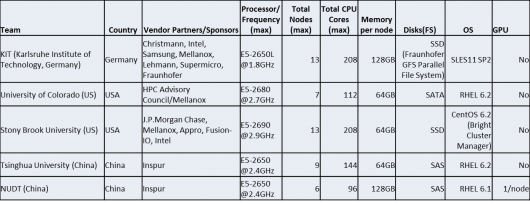The final system configurations for the ISC 2012 Student Cluster Competition have been locked down. For the ISC inaugural event, we’re seeing a lot of sameness but some differentness too. (Now that is a great sentence.)
On the ‘same’ side, every team is sporting various flavors of Intel Sandy Bridge processors, with speeds ranging from (Team Germany) KIT’s low-powered 1.8GHz E5-2650s to Stony Brook’s 2.9GHz E5-2690s. Everyone is also running some flavor of Linux, with most opting for Red Hat.
You’ll notice that I appended the term ‘max’ in several of the columns. This is because the chart below represents the gear the students brought with them, not what they’ll necessarily be running or the speeds they’ll be using.
The only limitation in the contest is power – there’s a hard cap of 220 volts at 13 amps. And it’s a truly ‘hard’ cap. At the SC version of the event, the student teams could vary above their power cap for a minute or two before getting a warning to crank things down. At ISC, they simply can’t get any more power – just like the real world, as competition organizers point out.
All of the teams tested their systems at home, but they needed to fine-tune their configs to take into account the power level at the event location. So even though they might have brought a huge number of cores that can run at high frequencies, it’s almost certain that they’ll need to either disable nodes or run them at slower speeds in order to stay under the power limit.
It’s interesting to peruse the table and note that there are significant differences from team to team. KIT and Stony Brook have more cores than anyone else, but opted for slower CPUs and doubled up on memory. At the last SC version of this competition, almost half the teams used GPUs as accelerators. It seemed to pay off; the GPU-enabled configurations took four of the top five finishes.
But here at ISC, only China’s NUDT team is using GPUs. All of the other teams said that the apps didn’t seem to be a good fit for GPUs. This is pretty much what the non-GPU teams said at the SC competition back in November – again, except for NUDT and, of course, the eventual winner, Taiwan’s Tsinghua University.
It’ll be interesting to see how this all plays out. Will high core counts make the difference? Will NUDT’s GPU-centric strategy pay off? Will the competition come down to hardware power or the students’ ability to handle the software configuration and optimization?
Posted In: Latest News, ISC 2012 Hamburg
Tagged: Student Cluster Competition, NUDT, GPU, ISC 2012, Tsinghua University, KIT, University of Colorado, Stony Brook University, CPU, Configurations

